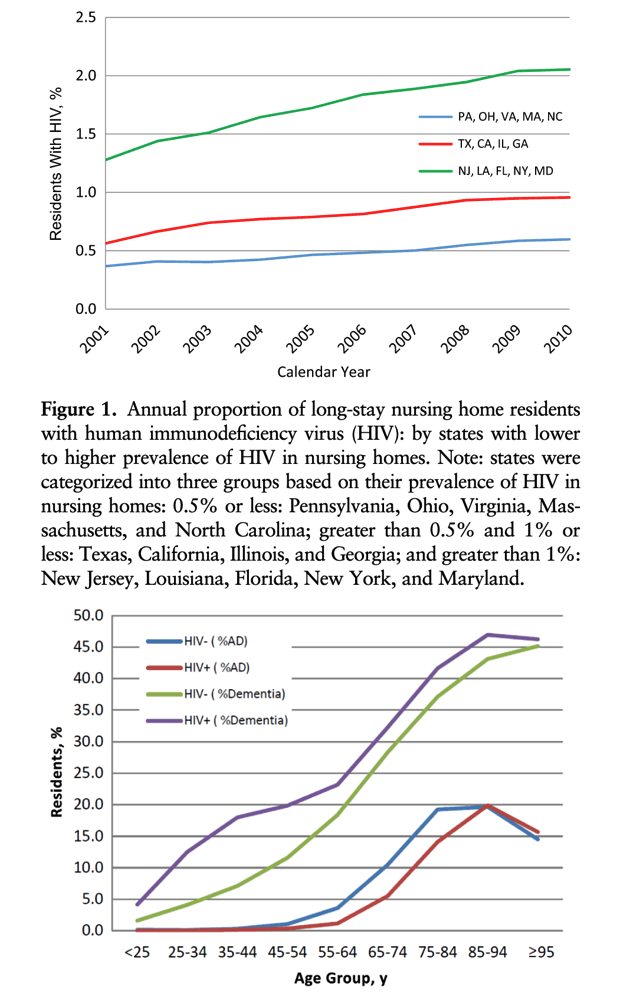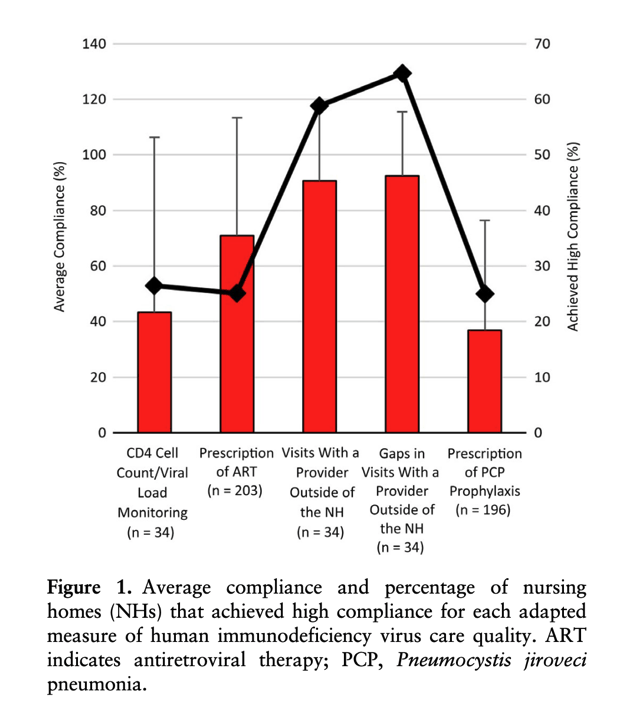| |
PLWH and Nursing Homes Report
5 Publications on Nursing Homes & PLWH
|
| |
| |
Nursing Home Residents by Human Immunodeficiency Virus Status: Characteristics, Dementia Diagnoses, and Antipsychotic Use - Download the PDF here
What Does Aging with HIV Mean for Nursing Homes? - Download the PDF here
Assessing the Quality of Human Immunodeficiency Virus Care in Nursing Homes - Download the PDF here
The Quality of Nursing Homes That Serve Patients With Human Immunodeficiency Virus - Download the PDF here
Use of antiretroviral therapy in nursing home residents with HIV - Download the PDF here
these studies report concerning problems with care provided to PWH in the nursing homes studied and raise questions about the quality of care PWH will receive in nursing homes
1 - Between 2001 and 2010, the prevalence of long-stay residents with HIV in NHs increased from 0.7% to 1.2%, a 71% increase, and given the rapid aging of the HIV population, this increase is likely to have continued.
Given the aging of persons with HIV in the United States and their increasingly likely need for NH care, study findings contribute evidence needed to ensure high-quality care for younger and older HIV+ NH residents.
Increases in prevalence were greater in states with higher proportions of HIV+ long-stay residents, and greatest in New Jersey, Louisiana, Florida, New York, and Maryland (Figure 1).
Figure 2 shows that HIV+ residents, compared to HIV- residents, had a higher prevalence of non-AD dementia until about the age of 95 years. These differences were greatest for HIV residents between the ages of 25 and 54 years. In contrast, AD was more common for HIV- residents compared to HIV+ residents between approximately the ages of 45 and 85 years.
For those aged 65 years or older, the prevalence of renal failure, diabetes, and cerebrovascular accident (CVA) was higher for HIV+ residents.
For residents with dementia, 35% of HIV+ residents were younger than 65 years compared to only 3% for HIV- residents.


MEASUREMENTS
Using Medicaid fee-for-service claims data in the years 2001 to 2010, together with Medicare resident assessment and Chronic Condition Warehouse data, we identified long-stay (more than 89 days) NH residents by HIV status and dementia presence. We examined dementia presence by age groups and APS medication receipt by younger (aged younger than 65 years) vs older (aged 65 years or older) residents, using logistic regression.
RESULTS
Between 2001 and 2010, the prevalence of long-stay residents with HIV in NHs increased from 0.7% to 1.2%, a 71% increase. Long-stay residents with HIV were younger and less often female or white. For younger NH residents, rates of dementia were 20% and 16% for HIV+ and HIV- residents, respectively; they were 53% and 57%, respectively, for older residents. In adjusted analyses, younger HIV+ residents with dementia had greater odds of APS medication receipt than did HIV- residents (AOR = 1.3; 95% confidence interval [CI] = 1.2-1.4), but older HIV residents had lower odds (AOR = 0.9; 95% CI = 0.8-0.9).
---------------------------
EDITORIAL
2 - What Does Aging with HIV Mean for Nursing Homes?….."prevalence of long-stay residents
(>89 d) with HIV increased 71% from 2001 to 2010….HIV continue to feel stigmatized and suffer discrimination in settings less familiar with HIV and its modern care.14-16 This may be particularly true in the nursing home setting where PLWH will continue to be a minority. Stigma can substantially limit engagement in medical care, adherence to ART, and quality of life among those aging with HIV infection. It may also prove a barrier to nursing home admission."
By 2030, 73% of people living with HIV in Europe are projected to be 50 years of age or older.2
Despite these trends, few studies have described the impact of aging with HIV on nursing home utilization. One study, published in the current issue of this journal, focused on long-stay nursing home residents from 2001 to 2010 and compared HIV-infected with uninfected residents. “Nursing Home Residents by HIV Status: Characteristics, Dementia Diagnoses, and Antipsychotic Use” by Susan C. Miller and colleagues used population-based Medicaid and Minimum Data Set data from 14 states with the highest HIV prevalence and found that the prevalence of long-stay residents (>89 d) with HIV increased 71% from 2001 to 2010.3 In the highest prevalence states of New Jersey, Louisiana, Florida, New York, and Maryland, the absolute proportion of nursing home residents living with HIV exceeded 2% by late 2008. If these trends have continued, nearly 4% of long-stay nursing home residents in these states are now people living with HIV (PLWH). Compared with long-stay nursing home residents without HIV infection, PLWH were 10 to 20 years younger, and dementia was more common in younger residents (among residents older than 65 years, 20% HIV-positive patients had dementia vs 16% uninfected).
Miller et al also found a greater use of antipsychotics among younger HIV-infected residents compared with younger uninfected residents. The fact that PLWH in nursing homes may be more likely to receive a potentially inappropriate medication (PIM) such as an antipsychotic, is concerning. The harmful effects of PIMs may be intensified among those aging with HIV. Those aging with HIV have greater levels of physiologic injury reflected in poorer liver, renal, and bone marrow function,4-6 making them more susceptible to adverse events associated with polypharmacy.
Of note, antiretroviral medications (ARVs) have important neurocognitive side effects and drug interactions. Among younger subjects, in the HIV-CAUSAL collaboration, a higher CNS Penetration Effectiveness score of the ARVs was associated with a 74% increased risk for dementia.7 Specific ARVs were associated with adverse neuropsychological events and neurocognitive impairment.8 Nucleoside reverse transcriptase inhibitors may lead to mitochondrial toxicity of neurons that can then cause neuropathy, psychosis, depression, and mania.8 Nonnucleoside reverse transcriptase inhibitors, most notably efavirenz, are also associated with adverse central nervous system drug effects including sleep disturbances, vivid dreams, depression, and cognitive impairments.9 These side effects and drug interactions have not been well studied among older PLWH.
In sum, much remains to be done if people with HIV are to be allowed to age with grace and dignity. Studies such as the one by Miller et al are a start. Let's get to work.
-----------------------------
3 - rate of ART use by HIV+ long-stay NH residents was low
Exactly 4171 eligible HIV+ residents from 2459 NHs were included in our study. Only 36% (1507 of 4171) received any ART regimen during an average of 11.6 months of observation. Older age, females, white race, receipt of Medicare skilled nursing benefits, and some major cardiometabolic comorbidities and mental health conditions were associated with non-ART use. Rates of non-ART use did not vary significantly by residents' end-of-life status (p = 0.21). Residents in facilities with a higher HIV concentration [adjusted odds ratio (adjOR) 3.42; 95% confidence interval (CI) 2.13–5.48] and an AIDS unit (adjOR 2.51; 95% CI 1.92–3.30) had higher odds of using an ART.
Conclusions and Implications
The rate of ART use by HIV+ long-stay NH residents was low. Facilities' experience with HIV played an important role in ART receipt. Interventions to improve rates of ART use in NHs are urgently needed to ensure optimal health outcomes.
-------------------------
4 - Persons with HIV were generally admitted to lower-quality NHs compared to persons without HIV. More efforts are needed to ensure that persons with HIV have access to high-quality NHs. J Am Geriatr Soc 67:2615–2621, 2019
We find that residents with HIV tend to be admitted to NHs with higher concentrations of HIV and lower quality than residents without HIV. This remains true when comparing residents who live in the same county as one another. PLWH are admitted to NHs that have higher survey deficiencies, higher readmission rates, and lower star ratings.
Additionally, as HIV concentration increases, these quality indicators tend to get worse, with the exception of NHs with high (>50%) HIV concentration, which appear to be systematically different.
----------------------------
5 - Low Compliance With Care Standards for PWH - Assessing the Quality of Human Immunodeficiency Virus Care in Nursing Homes
PARTICIPANTS
A total of 203 NHs and 1375 persons living with HIV.
RESULTS
Compliance ranged from 43.3% (SD = 31.1%) for CD4/viral load monitoring to 92.4% (SD = 13.6%) for gaps in medical visits. More substantiated complaints against an NH decreased the likelihood of high compliance with CD4/viral load monitoring (odds ratio [OR] = 0.846; 95% confidence interval [CI] = 0.726-0.986), while NH-reported incidents increased the likelihood of high compliance with pneumocystis pneumonia prophylaxis (OR = 1.173; 95% CI = 1.044-1.317). Differences between NHs explained 21.2% or less of variability in receipt of care.
NHs Evaluated for HIV Care Quality
Of the 203 NHs evaluated, 98 achieved high compliance. NHs had an average of 9.1 (SD = 11.2) persons living with HIV/AIDS, 151.7 (SD = 90.9) people in residence, and 172.4 (SD = 96.2) total beds. Most were for-profit institutions (83.7%) and part of a chain (66%). More than half (58.6%) were located in the South (Table 2).
Compliance on HIV Care Quality Measures
Average compliance ranged from 92.4% (SD = 13.6%) with gaps in medical visits outside of the NH to 36.9% (SD = 23.3%) with PCP prophylaxis (Figure 1). More NHs achieved high compliance with gaps in medical visits outside the NH (64.7%; 22/34) and frequency of medical visits outside the NH (58.8%; 20/34) than on other measures. The other measures had less than 30% of NHs achieve high compliance—PCP prophylaxis (25%; 49/203), prescription of ART (25.1%; 51/203), and CD4/viral load monitoring (26.5%; 9/34).

Predicting High Compliance
The organizational culture domain, quality measures–based improvement, represented by the number of substantiated complaints and the number of NH reported incidents, was the only organizational culture domain associated with facilities' achieving high compliance (Table 3). For each additional complaint, NHs were 15.4% less likely to achieve high compliance with CD4/viral load monitoring (odds ratio [OR] = 0.846; 95% confidence interval [CI] = 0.726-0.986). For each additional NH reported incident, there was a 17.3% increase in likelihood the NH would achieve high compliance with PCP prophylaxis (OR = 1.173; 95% CI = 1.044-1.317).
The concentration of persons living with HIV/AIDS in the NH was significantly associated with a small increase in the odds of high compliance with CD4 cell/viral load monitoring and prescription of ART (OR = 1.041 [95% CI = 1.004-1.08] and OR = 1.023 [95% CI = 1.004-1.043], respectively). However more persons living with HIV/AIDS in the NH meant compliance with frequency of medical visits outside of the NH (OR = 0.968; 95% CI = 0.938-0.998) and gaps in medical visits outside of the NH were less likely, the latter being a nonsignificant association (OR = 0.946; 95% CI = 0.88-1.017).
|
|
| |
| |
|
|
|